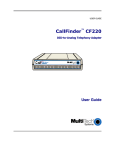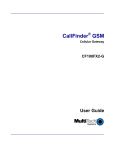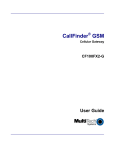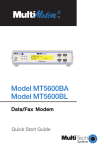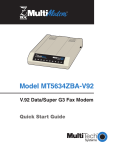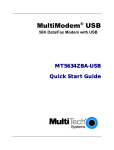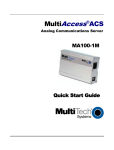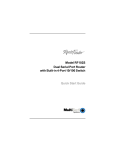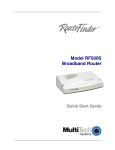Download Multitech CF220 User guide
Transcript
CallFinder® DID DID-to-Analog Adapter Model CF220-DID Cabling Guide CallFinder DID Cabling Guide Model CF220-DID 82100292L Copyright © 2008 by Multi-Tech Systems, Inc. All rights reserved. This publication may not be reproduced, in whole or in part, without prior expressed written permission from Multi-Tech Systems, Inc. Multi-Tech Systems, Inc. makes no representation or warranties with respect to the contents hereof and specifically disclaims any implied warranties of merchantability or fitness for any particular purpose. Furthermore, Multi-Tech Systems, Inc. reserves the right to revise this publication and to make changes from time to time in the content hereof without obligation of Multi-Tech Systems, Inc., to notify any person or organization of such revisions or changes. Check Multi-Tech’s web site for current versions of our product documentation. Record of Revisions Revision A B C Date 06/15/07 10/02/07 03/14/08 Description Initial release of CF220-DID Cabling Guide. Update support info and fix format. Update mechanical drawing. Trademarks CallFinder, FaxFinder, Multi-Tech, and the Multi-Tech logo are registered trademarks of Multi-Tech Systems, Inc. All other brand and product names mentioned in this publication are trademarks or registered trademarks of their respective companies. Multi-Tech Systems, Inc. 2205 Woodale Dr. Mounds View, MN 55112, USA (763) 785-3500 (800) 328-9717 Fax: 763-785-9874 www.multitech.com 2 TECHNICAL SUPPORT Country By E-mail By Phone Europe, Middle East, [email protected] (+44)118 959 7774 Africa U.S., Canada, All Others [email protected] (800) 972-2439; (763) 717-5863 MultiTech Systems, Inc. CallFinder Cabling Guide Introduction This guide describes the hardware setup of the CF220-DID CallFinder unit, and some preliminary considerations for its interoperation with PBX units. Instructions for software setup can be found in the User Guide. Mechanical Mounting The CF220-DID CallFinder can be surface mounted with screws spaced according to the dimensions shown. MultiTech Systems, Inc. 3 CallFinder Cabling Guide We Supply • A CallFinder (CF220-DID) with factory-installed software • A two-piece 9 Vdc power supply with power cord • Four common telephone cables (1 for each port; RJ-11 at both ends) • A product CD that contains: (a) a system management software package for the administrator’s PC, and (b) additional documentation for administrators • This printed Cabling Guide You Supply • A nearby AC power outlet • Two nearby connections to a PBX or key phone system • One or two nearby analog DID trunk lines each with a block of associated DID telephone numbers • A connection to your Ethernet LAN • A PC with an Ethernet connection and a web browser from which to configure the CallFinder unit. (Windows or Linux can be used to access the CallFinder software. Windows NT, Windows 2000, or Windows XP is required to access the Device Manager software.) 4 MultiTech Systems, Inc. CallFinder Cabling Guide CallFinder Operation The CallFinder brings analog DID services to a key telephone system or PBX that is not DID-enabled. Prerequisite: Ordering the DID Lines To operate the CallFinder system, you will need one or two DID (Direct Inward Dial) lines in your office. You must order the DID lines from your local telephone operating company (telco). A DID line allows one phone line to be associated with multiple directory numbers. However, only one call can occur on this line at any given time. DID lines are sold in groups. For example, a telco in New York City might offer a DID line with a set of 10 directory numbers in the range of 212-555-4100 through 212-555-4109. When ordering your DID line, ask the telco representative for these details about the DID service. These details will be important when setting up your CF220-DID unit. Parameter Value Required by Telco Number of digits used to designate the DID extension (usually 3, 4, 6, or 7) Type of “DID Start” used (wink, immediate, or delay dial) You will need this information to configure your CallFinder unit later. MultiTech Systems, Inc. 5 CallFinder Cabling Guide Quick Hookup for CF220-DID CallFinder CF220-DID Hookup Cabling to telco DID lines. Connector at CallFinder: RJ-11. Connector at telco end: RJ-11. CHANNEL 2 CHANNEL 1 Reset Switch Power Cable Receptacle 10/100 RESET FXS/FXO DID FXS/FXO DID To Cabling to your Ethernet LAN. Earth Ground RJ-45 connector. Cabling to PBX. FXO to PBX Station Port. FXS to PBX Trunk Port. Connectors: RJ-11 at both ends. 6 MultiTech Systems, Inc. CallFinder Cabling Guide Cabling Instructions Summary: Place the CallFinder in a convenient location, and then connect it to earth ground, to your AC power outlet, to your Ethernet network, and to your telco DID service. You cannot connect the CallFinder's Extension Ports (FXS/FXO) to your PBX until after you have configured the CallFinder software. In the CallFinder software, you will configure the Extension Ports as either FXS or FXO, and this must be done before they can be connected to your PBX. Connect CallFinder to Earth Ground Connect the CallFinder’s ground connector to a true earth ground (the ground of your building’s electrical system). Product Ground Screw Ground Wire: Size 18AWG or thicker Earth Ground Screw: Connected to Permanent Earth Ground of Building’s Electrical System Grounding connectors must be secured permanently to product ground screw and earth ground screw. GND MultiTech Systems, Inc. 7 CallFinder Cabling Guide Connect CallFinder to Power Insert the 9 Vdc power connector into the CallFinder’s power receptacle and fasten it with the lock nut. Connect the female end of the AC cord to the power block. Then plug the AC cord into the power outlet. Caution: Use only the 9 Vdc power transformer supplied with the CallFinder. Use of any other transformer voids the warranty and can damage the CallFinder. Lock Nut 8 MultiTech Systems, Inc. CallFinder Cabling Guide Verify powering. After power is applied, the PWR LED comes on immediately but there is a 4-second delay before the Status LED comes on. In normal operation, the Status LED will be flashing. When you apply power, the CallFinder performs a diagnostic self-test. The Status indicator flashes when the embedded processor is up and running. If the Status indicator does not flash, check that the power supply is solidly connected and that the AC outlet is live. Connect CallFinder to Ethernet Network Plug one end of your RJ45 Ethernet cable into the CallFinder’s Ethernet jack (labeled “10/100”) and the other end into your network Ethernet hub. This Ethernet cable is not included with your CallFinder unit. Note: Before connecting to the Ethernet Network, make sure that the network to which you are connecting the CallFinder is not a 192.168.2.x subnet. MultiTech Systems, Inc. 9 CallFinder Cabling Guide If it is a 192.168.2.x subnet, it may clash with the CallFinder because the CallFinder’s default IP address is 192.168.2.1. To remedy such a situation, connect directly from the Admin PC to the CallFinder using an RJ45 cable until the CallFinder’s IP address has been configured. Thereafter, connect the CallFinder into the network. Connect CallFinder to DID Lines Plug one end of the phone cable into the CallFinder’s Channel 1 DID jack and the other end into an analog DID trunk line jack. The DID Line cable is included with your CallFinder. Caution: Never plug the DID connector into a standard POTS Line. This may damage the CallFinder or the central office equipment. Use only an analog DID Line. Repeat for the CallFinder’s Channel 2 DID port. 10 MultiTech Systems, Inc. CallFinder Cabling Guide Identify CallFinder’s Extension Ports (FXS/FXO) for Later Hookup Caution: You must wait until after the CallFinder software has been configured before connecting the cables between the CallFinder’s Extension (FXS/FXO) Ports and the PBX. Because the CallFinder and the PBX can both supply battery power, the cable connections must be done properly. Otherwise equipment damage could occur. Before making connections to the CallFinder Extension (FXS/FXO) channels, you must know the type of PBX port to which each CallFinder port will be connected and set the “Extension Port” field in the CallFinder Channel Configuration screen appropriately. When connecting to a PBX Station Port, set the CallFinder channel to FXO. When connecting to a PBX Trunk Port, set the CallFinder channel to FXS. When the Channel Configuration | Extension Port software field has been set properly for both CallFinder channels, you can proceed to connect the cable between each of the CallFinder’s FXS/FXO ports and the corresponding PBX port. MultiTech Systems, Inc. 11 Patents This device is covered by one or more of the following patents: 6,031,867; 6,012,113; 6,009,082; 5,905,794; 5,864,560; 5,815,567; 5,815,503; 5,812,534; 5,809,068; 5,790,532; 5,764,628; 5,764,627; 5,754,589; D394,250; 5,724,356; 5,673,268; 5,673,257; 5,644,594; 5,628,030; 5,619,508; 5,617,423; 5,600,649; 5,592,586; 5,577,041; 5,574,725; D374,222; 5,559,793; 5,546,448; 5,546,395; 5,535,204; 5,500,859; 5,471,470; 5,463,616; 5,453,986; 5,452,289; 5,450,425; D361,764; D355,658; D355,653; D353,598; D353,144; 5,355,365; 5,309,562; 5,301,274. Other patents pending. 82100292L












